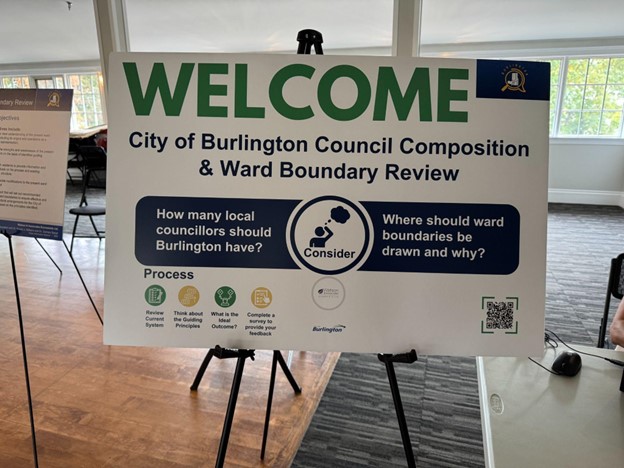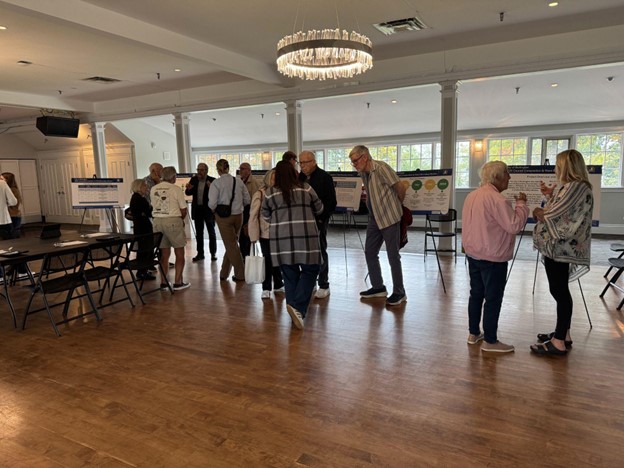By Jack Brittle, Local Journalism Initiative Reporter
On October 23, the City of Burlington held a consultation and ward boundary review for the Aldershot area.
The event was held in the LaSalle Pavillion, located in LaSalle Park and was well-attended relative to other similar gatherings, according to a city employee.
Among the attendees was Jim Young, chair of Partnering Aldershot, who shared his thoughts on the gathering.
“I think it’s important, if for no other reason than people deserve to be well informed,” Young said. “Other than your city taxes, the most important thing the city does for you is run your elections, and they are determined by your ward boundaries.”
Young said that along with taxes, this may be the most important input that citizens can provide to the city.
Young said events like this only happen after two council cycles. He also said the current council has been a lot better at listening to the concerns of citizens over the last six years than in years past.
“The Transit Users’ Forum used to be the opposition…now it tends to be more of a supportive thing,” Young said.
The city did not originally plan to hold a consultation event in Aldershot, but after Partnering Aldershot sent a delegation to the city asking them to increase the number of outreach events, the city agreed to organize one in the area.
Young said that for years, many Aldershot residents felt shunned by the council, but that in recent years that attitude has changed.
Young said that his biggest concern right now when it comes to redrawing the ward map is the disproportionate number of new developments in Aldershot relative to the rest of the city.
“If you look at the city of Burlington, there are almost 48,000 housing units under consideration,” Young said. “From pre-application to almost confirmed, and almost 20,000 of them are going to be in Aldershot.”
“Will that reflect in the new ward boundaries,” Young said, “if Aldershot suddenly becomes a huge population, do you now have a smaller ward, with more people in it? And if you have a smaller ward, does one end of Aldershot miss out on that?”

Consultant Dr. Robert J. Williams was also present at the event, fielding questions and listening to residents’ concerns. Williams has participated as a consultant on several ward boundary reviews for different cities, including those for Kitchener, Pickering, and Haldimand County.
After initially working as an independent advisor, he joined the economic consulting firm Watson and Associates several years ago.
Williams says that before doing any advising, he first meets with the council of the community he is working for to see how the system works and visits neighbourhoods to see how they fit together and “visualize the nuances” within them.
He said that over the past few elections, council composition has become a growing topic of debate.
“It was always there, but in many cases, the municipality was not interested in changing the number of councillors,” Williams said. “But it’s becoming a growing concern since we saw population growth, especially without having the right-sized council to do the work as expected.”
Williams said that there is no standard formula for council composition and that sometimes there are some “rather unusual combinations.”
“In the early stage, one of the questions we often ask is, why do you do it that way,” Williams said. “And what’s interesting is in a lot of cases, they don’t know whether it was something that was decided by the province, or when an amalgamation took place. And even though there were amalgamations in the late 90s, it’s still not easy to pin down why certain things were done.”
He said that these kinds of reviews are essential when a community is experiencing or expecting significant population growth.
“When you look at a map and you see a ward with a very high population compared to others, I would say that in 99% of the cases I’ve dealt with, population growth will not fix it. It will only get worse,” Williams said.
Williams said that the Municipal Act does not include any guidelines for how wards or councils need to be set up, other than necessitating at least four councillors and one mayor.

Burlington currently has six councillors because that is what was decided when the city became a part of Halton Region.
Williams said that some communities don’t even use wards, or elect two councillors per ward instead of one.
After phase one of the consultation, the city will come back with several preliminary options and redrawn maps to accompany them. These options are also malleable, according to Williams, and can change or, in some cases, merge as a result of community feedback.
He spoke about some of the concerns that he heard from citizens at the event.
“I’ve heard a lot about impending growth, and how Burlington is not going to stay the same,” Williams said. “It’s going to see significant growth in certain locations. And is that fair to the residents in Ward 1 that are going to see 20,000 more people? Are you going to get a good representation of that? So you need to think about that growth.”
Williams also said that how the communities in Burlington are linked together was also something that was brought up quite frequently.
“This area and its three sub-areas seem to have a strong affinity for each other,” Williams said. “But can they be kept together if the numbers are way up?”
He also said that many residents were seemingly unaware that each ward councillor also serves as a councillor for Halton Region. Williams said that changing that current arrangement can also be something that is up for debate.
“It’s not a comment on how well the people currently do the job, but it’s an enormous burden on those officials to have a role in two governments,” Williams said.
Williams said that the second phase of the review will most likely take place late in the winter season.




